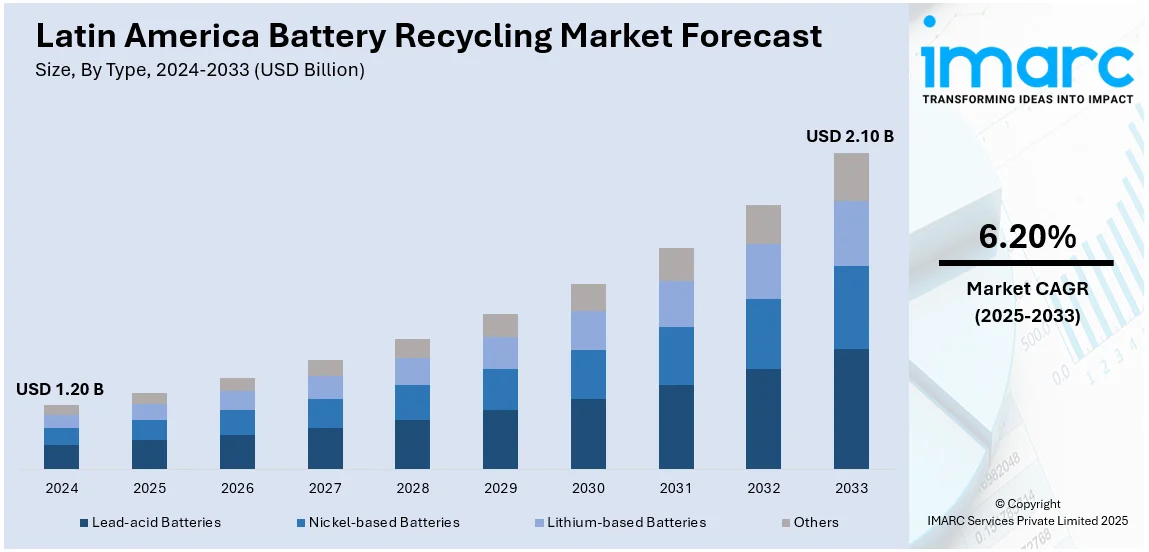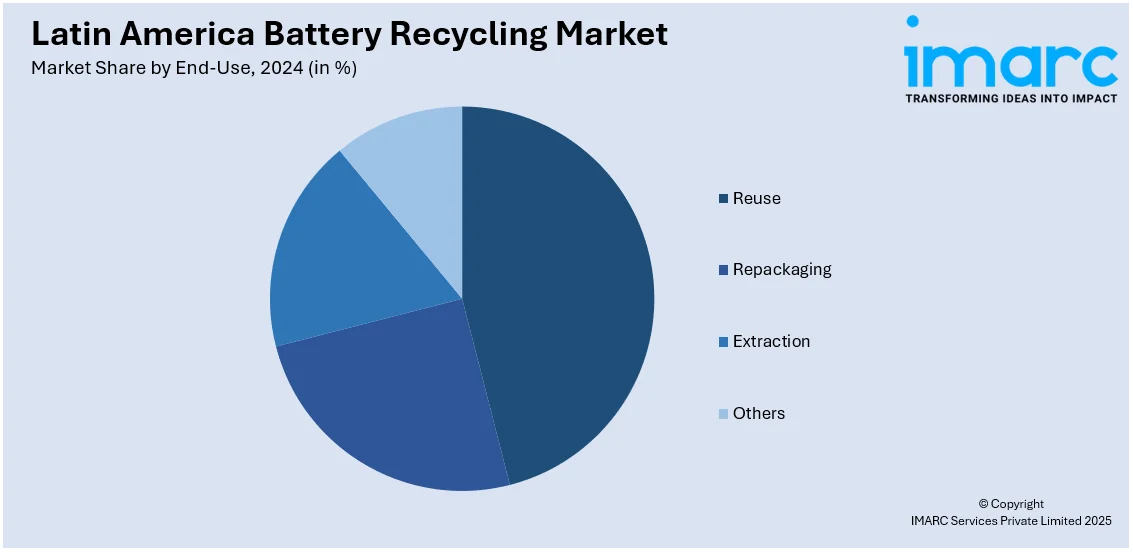
Latin America Battery Recycling Market Size, Share, Trends and Forecast by Type, Source, End-Use, Material, and Region, 2025-2033
Latin America Battery Recycling Market Overview:
The Latin America battery recycling market size reached USD 1.20 Billion in 2024. Looking forward, IMARC Group expects the market to reach USD 2.10 Billion by 2033, exhibiting a growth rate (CAGR) of 6.20% during 2025-2033. The rising demand for electric vehicles (EVs) and renewable energy storage solutions, accompanied by heightened investments in clean energy initiatives, is propelling the battery recycling market in Latin America. Effective recycling of lithium-ion batteries is crucial for minimizing waste, reclaiming valuable resources, and promoting sustainable energy alternatives.
|
Report Attribute
|
Key Statistics
|
|---|---|
|
Base Year
|
2024 |
|
Forecast Years
|
2025-2033
|
|
Historical Years
|
2019-2024
|
| Market Size in 2024 | USD 1.20 Billion |
| Market Forecast in 2033 | USD 2.10 Billion |
| Market Growth Rate (2025-2033) | 6.20% |
Latin America Battery Recycling Market Trends:
Rising Demand for Electric Vehicles (EVs) and Energy Storage Solutions
The increasing use of electric vehicles (EVs) and renewable energy storage solutions in Latin America is becoming a significant factor for the region's battery recycling industry. A report from the Latin American Energy Organization (Olade) indicates that electric vehicle sales in the area increased by 60% in 2024, emphasizing the swift shift towards cleaner transportation alternatives. As governments throughout Latin America persist in advocating for cleaner energy options, supported by more stringent emission laws, the need for lithium-ion batteries is continuously increasing. These batteries are essential not just for driving electric vehicles but also play a key role in renewable energy storage solutions, like those employed in solar and wind energy systems. The rise in EV adoption and renewable energy solutions is matched by an escalating demand for effective recycling methods to handle the surging quantity of spent batteries. Recycling lithium-ion batteries is crucial for reclaiming important materials such as lithium, cobalt, and nickel, which can be repurposed in creating new batteries, thereby lessening the ecological effects of mining and extraction of raw materials. Moreover, the growth of EV infrastructure and government incentives focused on advancing green technologies is increasing battery waste volume, which in turn boosts the demand for recycling services in the region.

Rapid expansion of renewable energy projects
As nations throughout the region increase their investments in solar and wind energy initiatives, the demand for substantial battery storage systems to handle fluctuating energy production is rising. In 2024, the International Finance Corporation (IFC) allocated $40 Billion to Origo Energia to assist in financing the creation of 22 small, ground-mounted solar DG projects in Brazil, with a total capacity of 90 MWp. This investment emphasizes the wider trend of increasing renewable energy projects, where batteries are crucial for storing energy generated from these sources. With the rise in renewable energy systems, the need for efficient battery recycling solutions to handle the end-of-life for these batteries also grows. Recycling is vital for minimizing waste, avoiding environmental pollution, and reclaiming important materials like lithium, cobalt, and nickel, which are necessary for creating new batteries. The increasing overlap between renewable energy and battery recycling is establishing a developing and hopeful growth sector. As governments advocate for cleaner energy options and better resource management practices, firms in the battery recycling industry are preparing to take advantage of these developments.
Latin America Battery Recycling Market Segmentation:
IMARC Group provides an analysis of the key trends in each segment of the market, along with forecasts at the regional level for 2025-2033. Our report has categorized the market based on type, source, end-use, and material.
Type Insights:
- Lead-acid Batteries
- Nickel-based Batteries
- Lithium-based Batteries
- Others
The report has provided a detailed breakup and analysis of the market based on the type. This includes lead-acid batteries, nickel-based batteries, lithium-based batteries and others.
Source Insights:
- Industrial
- Automotive
- Consumer Products
- Electronic Appliances
- Others
A detailed breakup and analysis of the market based on the source have also been provided in the report. This includes industrial, automotive, consumer products, electronic appliances, and others.
End-Use Insights:

- Reuse
- Repackaging
- Extraction
- Others
The report has provided a detailed breakup and analysis of the market based on the end-use. This includes reuse, repackaging, extraction, and others.
Material Insights:
- Manganese
- Iron
- Lithium
- Nickel
- Cobalt
- Lead
- Aluminium
- Others
A detailed breakup and analysis of the market based on the material have also been provided in the report. This includes manganese, iron, lithium, nickel, cobalt, lead, aluminium, and others.
Regional Insights:
- Brazil
- Mexico
- Argentina
- Colombia
- Chile
- Peru
- Others
The report has also provided a comprehensive analysis of all the major regional markets, which include Brazil, Mexico, Argentina, Colombia, Chile, Peru, and others.
Competitive Landscape:
The market research report has also provided a comprehensive analysis of the competitive landscape. Competitive analysis such as market structure, key player positioning, top winning strategies, competitive dashboard, and company evaluation quadrant has been covered in the report. Also, detailed profiles of all major companies have been provided.
Latin America Battery Recycling Market News:
- In February 2024, “Recycling and Reuse of Lithium Batteries in Latin America and the Caribbean: Analytical Review of Global and Regional Practices,” released by the Inter-American Development Bank (IDB), offered a comprehensive examination of worldwide and regional methods related to the recycling and reuse of lithium batteries in Latin America and the Caribbean.
Latin America Battery Recycling Market Report Coverage:
| Report Features | Details |
|---|---|
| Base Year of the Analysis | 2024 |
| Historical Period | 2019-2024 |
| Forecast Period | 2025-2033 |
| Units | Billion USD |
| Scope of the Report |
Exploration of Historical Trends and Market Outlook, Industry Catalysts and Challenges, Segment-Wise Historical and Future Market Assessment:
|
| Types Covered | Lead-acid Batteries, Nickel-based Batteries, Lithium-based Batteries, Others |
| Sources Covered | Industrial, Automotive, Consumer Products, Electronic Appliances, Others |
| End-Uses Covered | Reuse, Repackaging, Extraction, Others |
| Materials Covered | Manganese, Iron, Lithium, Nickel, Cobalt, Lead, Aluminium, Others |
| Regions Covered | Brazil, Mexico, Argentina, Colombia, Chile, Peru, Others |
| Customization Scope | 10% Free Customization |
| Post-Sale Analyst Support | 10-12 Weeks |
| Delivery Format | PDF and Excel through Email (We can also provide the editable version of the report in PPT/Word format on special request) |
Key Questions Answered in This Report:
- How has the Latin America battery recycling market performed so far and how will it perform in the coming years?
- What is the breakup of the Latin America battery recycling market on the basis of type?
- What is the breakup of the Latin America battery recycling market on the basis of source?
- What is the breakup of the Latin America battery recycling market on the basis of end-use?
- What is the breakup of the Latin America battery recycling market on the basis of material?
- What is the breakup of the Latin America battery recycling market on the basis of region?
- What are the various stages in the value chain of the Latin America battery recycling market?
- What are the key driving factors and challenges in the Latin America battery recycling market?
- What is the structure of the Latin America battery recycling market and who are the key players?
- What is the degree of competition in the Latin America battery recycling market?
Key Benefits for Stakeholders:
- IMARC’s industry report offers a comprehensive quantitative analysis of various market segments, historical and current market trends, market forecasts, and dynamics of the Latin America battery recycling market from 2019-2033.
- The research report provides the latest information on the market drivers, challenges, and opportunities in the Latin America battery recycling market.
- Porter's five forces analysis assist stakeholders in assessing the impact of new entrants, competitive rivalry, supplier power, buyer power, and the threat of substitution. It helps stakeholders to analyze the level of competition within the Latin America battery recycling industry and its attractiveness.
- Competitive landscape allows stakeholders to understand their competitive environment and provides an insight into the current positions of key players in the market.
Need more help?
- Speak to our experienced analysts for insights on the current market scenarios.
- Include additional segments and countries to customize the report as per your requirement.
- Gain an unparalleled competitive advantage in your domain by understanding how to utilize the report and positively impacting your operations and revenue.
- For further assistance, please connect with our analysts.
 Request Customization
Request Customization
 Speak to an Analyst
Speak to an Analyst
 Request Brochure
Request Brochure
 Inquire Before Buying
Inquire Before Buying




.webp)




.webp)












